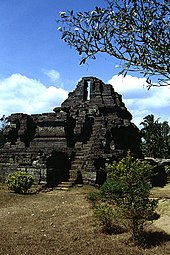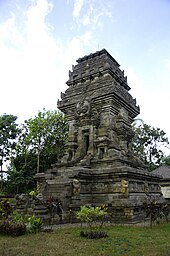Malang
| Malang | ||
|---|---|---|
|
|
||
| Coordinates | 7 ° 58 ′ S , 112 ° 38 ′ E | |
| Symbols | ||
|
||
| Basic data | ||
| Country | Indonesia | |
|
Geographical unit |
Java | |
| province | Java Timur | |
| ISO 3166-2 | ID-JI | |
| surface | 252.1 km² | |
| Residents | 752,020 (2007) | |
| density | 2,982.7 Ew. / km² | |
Malang is the eighth largest city on the Indonesian island of Java . It is located in the eastern part of the island.
Malang is surrounded by the regions of Tumpang, Batu, Singosari and Turen. At the time of the Asian crisis , the city was largely spared the effects and was able to develop unhindered.
During the Dutch colonial era and due to its proximity to the port of Surabaya , Malang was a popular destination for Europeans living in Indonesia .
history
The history of Malang goes back to the 8th century. In the 17th century Malang was first incorporated into the Mataram region and later colonized by the Dutch. In 1879 Malang was connected to the network of the Java railway line, which drove industrialization forward. There were also shorter private routes into the area. The growing population posed new problems for the government, with the focus on the question of affordable housing for the population.
geography
The total size of Malang is 124,456 km 2 . The city is bordered by Pasuruan to the north, Lumajang to the east and Batu to the west. To the east of the city there is an extensive volcanic massif, u. a. with Mount Bromo (a tourist attraction) and Mount Semeru, the tallest mountain in Java. Both volcanoes are active, ash eruptions from Semeru occur several times an hour.
climate
|
Average monthly temperatures and rainfall for Malang
Source: [1]
|
||||||||||||||||||||||||||||||||||||||||||||||||||||||||||||||||||||||||||||||||||||||||||||||||||||||||||||||||||||||||
population
About 780,000 people live in Malang, the population density is 5,000–12,000 / km 2 . The growth rate is 3.9% per year. Most of the Javanese and Madurans live in Malang, with a small percentage being Arab and Chinese descendants. The largest language group in Malang is Javanese.
religion
Most of the population are Muslims , while the minority are Protestants, Catholics , Hindus, Buddhists and Confucians .
education
The University of Brawijaya , the Merdeka University and the Business School STIEKN Jaya Negara are based in Malang.
Culture
Malang offers many different tourist attractions. This includes the traditional wayang performances, but also the proximity to the famous temples of the Singhasari empire from the 13th century.
Surroundings
12 km north of Malang is the syncretic Hindu - Buddhist shrine Candi Singhasari (Singosari Candi also wrote) that the god Shiva was dedicated. It was to become the grave monument for King Kertanagara, who was murdered in a palace revolution in 1292, the last and most important ruler of the Singhasari dynasty - grandfather of Tribhuwana Wijayattungga Dewi . The priests were killed with the king, an inscription from 1351 commemorates them. The actual temple was completed, but the sculptures could not be completed. The cubic cella rises on a low, square podium in the tower , which is extended to form a Greek cross with four porches . A second cube above it carries the three-tier roof, of which only two tiers have been preserved. Of the cult images inside, only Agastya , the divine teacher, who enjoyed great veneration on Java, still exists . On the large open space in the west stand two mighty, club-armored Dvarapalas . They are just as terrifying with bulging eyes as the kala heads above the doors and false doors of the temple.
In the town of Tumpang, about 25 km to the east, there is Candi Jago , a temple built between 1268 and 1280. It is the tomb of Vishnuvardhana, the father of Kertanagara. The sanctuary is laid out in three terraces on which the actual temple tower with the main cella rises. It contained three statues that had been found on the site and are now partially on view in the National Museum in Jakarta: the main statue was Amoghapāśa Lokeśvara, surrounded by the Bodhisattva Sudhana and Cyamatara (an Indonesian form of Shyama-Tara ). The rites practiced in the cella included the washing of the main statue. The water used for this was collected in a bowl formed by the edge of the base and then drained into two chiseled drainage channels. The rich relief decoration on the outside shows Buddhist and Hindu elements. Four ribbons run on the terraces around the temple and depict, on the one hand, doctrinal fables and , on the other, scenes from Mahabharata and Ramayana . The very flat-looking figures are reminiscent of the shadow figures of the wayang game, also in expression, costumes and hairstyle.
A few kilometers southwest of Tumpang stands the Candi Kidal in the village of Rejokidal. The slender temple of typical East Javanese architecture is the mausoleum for King Anushapati, who died in 1240, the second Singhasari ruler. The podium of the Hindu sanctuary, built in 1260, is decorated with reliefs on three sides. In the north Garuda wears a female deity, probably Sri , the wife of Vishnu who has emerged from the milk ocean . In the east Garuda can be seen with the vessel containing the "essence of immortality". In the south, the snake ( Vasuki ) , which is important for the “whisking of the ocean of milk”, is shown. A staircase on the west side leads to the tower that houses the cella with a statue that is no longer in existence. The kala heads above the portals and niches are particularly beautiful.
Malang is also the first starting point for many tours to the surrounding villages in the Bromo-Tengger-Semeru National Park , from where, for example, volcanoes used by tourists such as Bromo can be reached.
Personalities
Born here:
- Ben Stom (1886-1965), Dutch football player
- Edgar Beyfuß (1893–1936), German film manager, film director and film producer
- Johan Goslings (1903–1975), Dutch medic
- Robert “Rob” Pronk (1928–2012), Dutch jazz band leader, arranger, pianist and composer
- Rudini (1929–2006), politician and lieutenant general
- Anton C. Zijderveld (* 1937), Dutch sociologist
- Johan Wahjudi (1953-2019), badminton player
- Henricus Pidyarto Gunawan (* 1955), Roman Catholic religious, Bishop of Malang
- Munir Said Thalib (1965-2004), human rights and anti-corruption activist
- Hendrawan (* 1972), badminton player
- Variella Aprilsasi Putri Lejarsari (* 1990), badminton player
Died here:
- Max Dauthendey (1867–1918), German poet and painter
- Wilhelm Müller (1881–1916), German ethnologist
- Herman Joseph Sahadat Pandoyoputro (1939–2016), Roman Catholic Bishop of Malang
- Muljadi (1942-2010), badminton player
- Achmad Hasyim Muzadi (1944–2017), politician, chairman of the Central Board of Nahdlatul Ulama
literature
- Jacques Dumarçay: The Temples of Java . Oxford University Press, Singapore 1989, pp. 63-73 (The Temples of the Singosari Kings), ISBN 0-19-582595-0 .
- Heimo Rau: Indonesia . Kohlhammer Verlag, Stuttgart 1982, pp. 181-185, ISBN 3-17-007088-6 .





